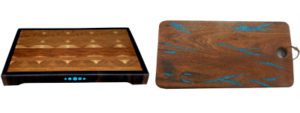How to Clean and Care for Wood Cutting Boards

Wooden cutting boards and kitchen utensils can retain their original beauty for many years with a bit of regular maintenance.
The best thing you can do for your wood cutting board or utensil is to clean it as soon as possible after each use. This will prevent the need for aggressive scrubbing to remove stuck on food. Use a mild dishwashing soap and a scrubby sponge with hot water to clean your wood items.
DO NOT soak them or put them in the dishwasher as prolonged soaking will warp or crack the wood and the heat from a dishwasher will dry it out. Dry the board/utensil after washing. Beware of moisture collection beneath the board if you leave it on the counter. It’s best to prop one end up to allow it to dry.
To keep you wood board and utensils looking new it’s important to recondition them periodically. Oiling and waxing a board is essential because detergents and soaps used for cleaning tend to dry out the wood, causing splits and and shortening the useful lifespan. It’s easy and gratifying to nourish your board and you will notice a big difference after you’re done. Simply follow these steps:
1. Make sure your board is clean and dry.
2. Apply a food safe mineral oil. How often you should oil you board depends on how frequently it is used. For boards that are used daily, we suggest a monthly application of oil. Boards and utensils that are used less frequently can be oiled 2-3 times a year. Do not use cooking oils such as vegetable oil or olive oil as these can turn rancid and cause bad odors. Rustic Artistry recommends this food safe mineral oil, which is made in the USA from pure USP grade white mineral oil.
Apply a few tablespoons of oil to the board (less for wood utensils) and wipe all over with a paper towel or clean soft cloth. It’s best to err on the side of too much oil than too little, as the board will absorb as much as it needs. Stand the board on end to allow air to circulate. Allow the oil to absorb overnight. Most likely it will be completely absorbed by morning, but if any oil remains on the surface just wipe it off with a paper towel or clean cloth. There is no need to wash the board after the oil treatment.
2. It’s a good idea to occasionally deep condition you board with a board wax. This will provide long-lasting protections and give your board a lovely sheen. Boos Butcher Block Board Cream is made from unbleached beeswax and food grade mineral oil. Apply the cream directly to the cutting board or wood utensil with a paper towel or soft cloth and rub into the grain. Allow to penetrate a few hours, or preferably, overnight. Buff off any excess wax from the wood.
To eliminate garlic, onion, fish, or other smells from you cutting board, try these methods:
~Rub the board with course salt or baking soda. Let stand a few minutes then rinse.
~Another very easy technique is to rub the cut side of half a lemon over the surface of the cutting board to neutralize onion and garlic odors.
If you have been cutting meat on your board and want to disinfect and sanitize it do the following: Fill a spray bottle with 4 parts water to 1 part distilled white vinegar. The acetic acid in the vinegar is a good disinfectant and can be safely used by people with chemical allergies. Spray the board liberally. Let it sit for 5 minutes and then wipe dry.

